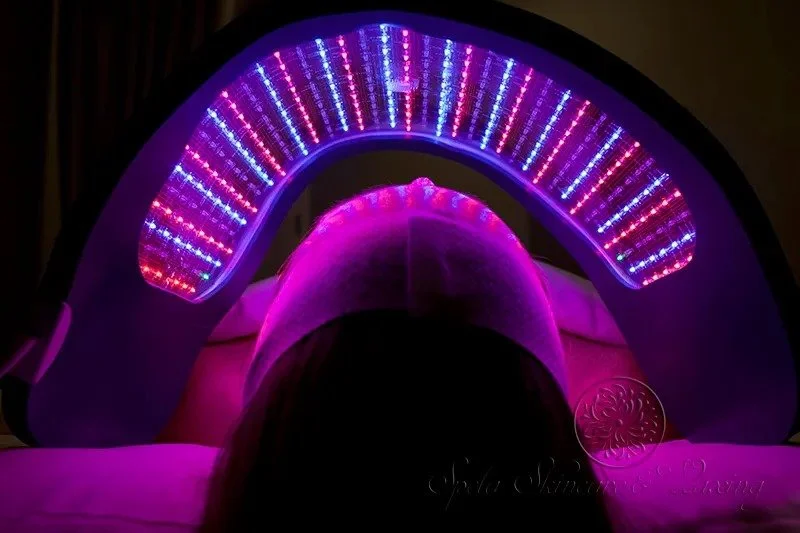Shedding Light on Beauty: Discover the Benefits of LED Light Therapy
Have you ever found yourself standing in front of a mirror, looking at your reflection, and feeling frustrated as you notice the fine lines, dark spots, or even unwelcome acnes that seem to have set up camp on your face? Trust us, you’re not alone.
Fact is, the daily onslaught of environmental stressors can wreak havoc on our skin, leaving us searching desperately for solutions that will make them all go away. The good news is that the skincare industry has come a long way, adapting cutting-edge technology to combat these types of skin concerns. One such technology that has been creating a buzz in recent years is LED Light Therapy.
What is LED light therapy?
LED light therapy is a non-invasive skincare treatment that utilizes light-emitting diodes (LED) that emit different colors or wavelengths of light that penetrates the skin at different depths. These lights stimulate cellular activity within the skin, helping boost collagen production, remove acne-causing bacteria, speed up the healing of wounds, etc. It’s a painless and safe treatment that doesn’t require any downtime, making it a popular choice for people looking to improve their skin’s appearance and health.
What are the benefits of LED light therapy?
Each color of light in LED light therapy offers specific benefits, and the choice of light used will depend on your individual skin concerns and goals. The most common lights used in LED light therapy are red and blue, but there are also other colors such as green and yellow which are not as popular but still have their own unique benefits.
Red light
Red light is usually used to treat aging skin because it stimulates collagen production, reducing wrinkles and improving skin elasticity. It enhances blood circulation, promotes a healthier complexion, and helps fade scars and hyperpigmentation. This light also soothes inflammation, making it suitable for people suffering from rosacea or those that have sensitive skin.
Blue light
Blue light targets and destroys acne-causing bacteria known as Propionibacterium acnes (P. acnes), effectively reducing breakouts and preventing future ones. It also controls excess oil production, keeping pores clear and minimizing acne. Additionally, blue light also calms inflammation and redness associated with acne, and can even be used to treat other skin conditions like eczema and psoriasis.
Amber Light
Amber light, also known as orange light, is one of the less commonly used colors in LED light therapy compared to red or blue light. However, it does offer some unique benefits for the skin especially when combined with red light. Together, they help calm skin inflammation and redness. On its own, amber light can improve skin clarity and brighten the complexion. It may assist in reducing the appearance of dull or uneven skin tone, resulting in a more radiant and even complexion.
Green Light
Green light is also less commonly used in LED light therapy because its benefits are relatively specific. It primarily focuses on improving skin tone and reducing hyperpigmentation, including dark spots and age spots. While green light can be effective for these concerns, it may not address a wide range of skin issues as comprehensively as red or blue light. However, for individuals specifically targeting pigmentation issues, green light can still be beneficial.
Yellow Light
Similar to amber and green light, yellow light is not as popular in LED light therapy due to its more specific benefits. Yellow light promotes cell turnover, leading to a smoother skin texture, and it helps reduce redness and inflammation. However, it may not have the broad spectrum of effects seen with red and blue light, which target collagen production, acne-causing bacteria, and other common skin concerns.
Near-Infrared Light
Near-infrared light penetrates deeper into the skin, promoting collagen and elastin production for firmer skin. It boosts circulation, delivering more oxygen and nutrients to the skin cells. This light helps reduce inflammation and accelerates the healing of wounds, making it particularly beneficial in post-treatment recovery. Over time, it can improve the appearance of scars and stretch marks. Near-infrared light supports overall skin rejuvenation and provides anti-aging effects.
LED light therapy options
At-Home LED Light Therapy
With at-home LED light therapy, you can bring the treatment right into your own home. Nowadays, many at-home handheld LED devices are available in the market, so it is possible to DIY this treatment. At-home treatments offer convenience and flexibility, allowing you to incorporate LED light therapy into your skincare routine whenever you want. However, it’s important to note that a lot of at-home devices in the market may have slightly less intensity compared to professional-grade equipment, and it may take more time to achieve noticeable results. If you’re serious about investing in an at-home LED light therapy device, we recommend Spalina Skincare’s Time Master Pro. It’s a professional-grade low-frequency ultrasound with LED that works to firm up the skin and smooth out wrinkles.
In-Office LED Light Therapy
This option takes place in a skincare professional’s clinic or spa. They use high-end LED devices that offer greater intensity and customization options. They also have the expertise to assess your skin condition and tailor the treatment to your specific needs. In-office treatments may involve a series of sessions, and your esthetician can monitor your progress. They may also combine LED light therapy with other procedures, such as chemical peels or microdermabrasion, to enhance the overall effectiveness of the treatment. In-office LED light therapy provides a more comprehensive and potentially faster approach to achieving desired results.
When deciding between at-home and in-office LED light therapy, consider factors such as convenience, cost, intensity, customization, and the severity of your skin concerns. At-home treatments offer flexibility and affordability, while in-office treatments provide professional expertise, advanced equipment, and the potential for combined therapies, hence guaranteed effectiveness. It’s always best to consult with a licensed esthetician to determine the most suitable option based on your specific goals and preferences.
Watch the video here:
